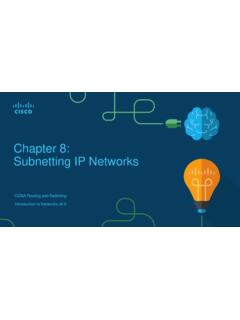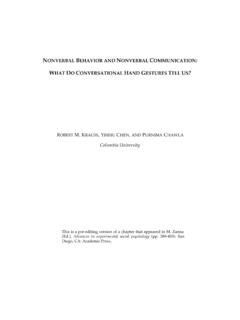Transcription of Chapter 3: Network Protocols and Communication
1 Chapter 3: Network Protocols and Communication CCNA Routing and Switching Introduction to Networks 2 2016 Cisco and/or its affiliates. All rights reserved. Cisco Confidential Rules of Communication Explain how rules facilitate Communication . Describe the types of rules that are necessary to successfully communicate. Network Protocols and Standards Explain the role of Protocols and standards organizations in facilitating interoperability in Network communications. Explain why Protocols are necessary in Network Communication . Explain the purpose of adhering to a protocol suite. Explain the role of standards organizations in establishing Protocols for Network interoperability. Explain how the TCP/IP model and the OSI model are used to facilitate standardization in the Communication process. Data Transfer in the Network Explain how devices on a LAN access resources in a small to medium-sized business Network . Explain how data encapsulation allows data to be transported across the Network .
2 Explain how local hosts access local resources on a Network . Chapter 3 - Sections & Objectives 3 2016 Cisco and/or its affiliates. All rights reserved. Cisco Confidential Rules of Communication 4 2016 Cisco and/or its affiliates. All rights reserved. Cisco Confidential All Communication methods have three elements in common: Source or sender Destination or receiver Channel or media Rules or Protocols govern all methods of Communication . The Rules Communication Fundamentals 5 2016 Cisco and/or its affiliates. All rights reserved. Cisco Confidential Protocols are necessary for effective Communication and include: An identified sender and receiver Common language and grammar Speed and timing of delivery Confirmation or acknowledgment requirements Protocols used in Network communications also define: Message encoding Message delivery options Message Formatting and Encapsulation Message Timing Message Size The Rules Rule Establishment 6 2016 Cisco and/or its affiliates.
3 All rights reserved. Cisco Confidential Encoding between hosts must be in appropriate format for the medium. Messages are first converted into bits by the sending host. Each bit is encoded into a pattern of sounds, light waves, or electrical impulses depending on the Network media The destination host receives and decodes the signals in order to interpret the message. The Rules Message Encoding 7 2016 Cisco and/or its affiliates. All rights reserved. Cisco Confidential There is an agreed format for letters and addressing letters which is required for proper delivery. Putting the letter into the addressed envelope is called encapsulation. Each computer message is encapsulated in a specific format, called a frame, before it is sent over the Network . A frame acts like an envelope providing destination address and source address. The Rules Message Formatting and Encapsulation 8 2016 Cisco and/or its affiliates. All rights reserved. Cisco Confidential Humans break long messages into smaller parts or sentences.
4 Long messages must also be broken into smaller pieces to travel across a Network . Each piece is sent in a separate frame. Each frame has its own addressing information. A receiving host will reconstruct multiple frames into the original message. The Rules Message Size 9 2016 Cisco and/or its affiliates. All rights reserved. Cisco Confidential Access Method Hosts on a Network need to know when to begin sending messages and how to respond when collisions occur. Flow Control Source and destination hosts use flow control to negotiate correct timing to avoid overwhelming the destination and ensure information is received. Response Timeout Hosts on the Network have rules that specify how long to wait for responses and what action to take if a response timeout occurs. The Rules Message Timing 10 2016 Cisco and/or its affiliates. All rights reserved. Cisco Confidential Unicast Message Multicast Message Broadcast Message The Rules Message Delivery Options One-to-many delivery One-to-all delivery One-to-one delivery 11 2016 Cisco and/or its affiliates.
5 All rights reserved. Cisco Confidential Network Protocols and Standards 12 2016 Cisco and/or its affiliates. All rights reserved. Cisco Confidential protocol suites are implemented by hosts and networking devices in software, hardware or both. The Protocols are viewed in terms of layers, with each higher level service depending on the functionality defined by the Protocols shown in the lower levels. Protocols Rules that Govern Communications 13 2016 Cisco and/or its affiliates. All rights reserved. Cisco Confidential Networking Protocols define a common format and set of rules for exchanging messages between devices. Some common networking Protocols are Hypertext Transfer protocol (HTTP), Transmission Control protocol (TCP), and Internet protocol (IP). Protocols Network Protocols 14 2016 Cisco and/or its affiliates. All rights reserved. Cisco Confidential Communication between a web server and web client is an example of an interaction between several Protocols : HTTP - an application protocol that governs the way a web server and a web client interact.
6 TCP - transport protocol that manages the individual conversations. IP encapsulates the TCP segments into packets, assigns addresses, and delivers to the destination host. Ethernet - allows Communication over a data link and the physical transmission of data on the Network media. Protocols protocol Interaction 15 2016 Cisco and/or its affiliates. All rights reserved. Cisco Confidential A protocol suite is a set of Protocols that work together to provide comprehensive Network Communication services. May be specified by a standards organization or developed by a vendor. The TCP/IP protocol suite is an open standard, the Protocols are freely available, and any vendor is able to implement these Protocols on their hardware or in their software. protocol Suites protocol Suites and Industry Standards This course will only cover the Protocols of the TCP/IP protocol suite 16 2016 Cisco and/or its affiliates. All rights reserved. Cisco Confidential Advanced Research Projects Agency Network (ARPANET) was the predecessor to today s Internet.
7 ARPANET was funded by the Department of Defense for use by universities and research laboratories. protocol Suites Development of TCP/IP 17 2016 Cisco and/or its affiliates. All rights reserved. Cisco Confidential protocol Suites TCP/IP protocol Suite 18 2016 Cisco and/or its affiliates. All rights reserved. Cisco Confidential When sending data from a web server to a client the encapsulation procedure would be as follows: The webserver prepares the Hypertext Markup Language (HTML) page. The HTTP application layer protocol sends the data to the transport layer. The transport layer breaks the data into segments and identifies each. Next the IP source and destination addresses are added, creating an IP Packet. The Ethernet information is then added creating the Ethernet Frame, or data link frame. protocol Suites TCP/IP Communication Process This frame is delivered to the nearest router along the path towards the web client. Each router adds new data link information before forwarding the packet.
8 19 2016 Cisco and/or its affiliates. All rights reserved. Cisco Confidential When receiving the data link frames from the web server, the client processes and removes each protocol header in the opposite order it was added: First the Ethernet header is removed Then the IP header Then the Transport layer header Finally the HTTP information is processed and sent to the client s web browser protocol Suites TCP/IP Communication Process (Cont.) 20 2016 Cisco and/or its affiliates. All rights reserved. Cisco Confidential Open standards encourage interoperability, competition, and innovation. Standards organizations are usually vendor-neutral, non-profit organizations established to develop and promote the concept of open standards. Standards Organizations Open Standards 21 2016 Cisco and/or its affiliates. All rights reserved. Cisco Confidential Internet Society (ISOC) promotes open development and evolution of Internet use globally. Internet Architecture Board (IAB) - management and development of Internet standards.
9 Internet Engineering Task Force (IETF) - develops, updates, and maintains Internet and TCP/IP technologies. Internet Research Task Force (IRTF) - focused on long-term research related to Internet and TCP/IP Protocols . Standards Organizations Internet Standards Internet Corporation for Assigned Names and Numbers (ICANN) - coordinates IP address allocation and management of domain names. Internet Assigned Numbers Authority (IANA) - manages IP address allocation, domain name management, and protocol identifiers for ICANN. 22 2016 Cisco and/or its affiliates. All rights reserved. Cisco Confidential Institute of Electrical and Electronics Engineers (IEEE) - dedicated to advancing technological innovation and creating standards in a wide area of industries including networking. Electronic Industries Alliance (EIA) - standards related to electrical wiring, connectors, and Network racks. Telecommunications Industry Association (TIA) standards for radio equipment, cellular towers, Voice over IP (VoIP) devices, and satellite communications.
10 International Telecommunications Union-Telecommunication Standardization Sector (ITU-T) standards for video compression, Internet protocol Television (IPTV), and broadband communications. Standards Organizations Electronics and Communications Standard Organizations 23 2016 Cisco and/or its affiliates. All rights reserved. Cisco Confidential The benefits of using a layered model include: Assisting in protocol design since Protocols at each layer have defined functions. Fostering competition because products from different vendors can work together. Preventing technology changes in one layer from affecting other layers. Providing a common language to describe networking functions and capabilities. Reference Models The Benefits of Using a Layered Model 24 2016 Cisco and/or its affiliates. All rights reserved. Cisco Confidential Application - contains Protocols used for process-to-process communications. Presentation - provides for common representation of the data.










